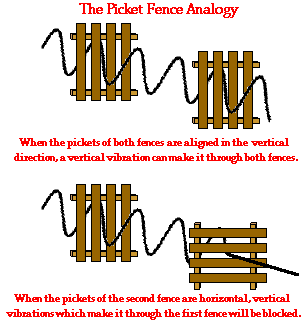Polarising waves
Hi all,
I'm trying to understand the polarisation of waves, and the OCR textbook has the following example (Sorry for my poor scanning abilities):

I thought that if the waves were coming out vertically plane polarised, the the bars of the metal grille would also have to be vertical to let the waves through, whereas horizontal would block them?
Sort of like this anaology:

Is the book wrong, or (more likely) have I missed something?
I'm trying to understand the polarisation of waves, and the OCR textbook has the following example (Sorry for my poor scanning abilities):
I thought that if the waves were coming out vertically plane polarised, the the bars of the metal grille would also have to be vertical to let the waves through, whereas horizontal would block them?
Sort of like this anaology:

Is the book wrong, or (more likely) have I missed something?
Original post by Sir_Malc
Hi all,
I'm trying to understand the polarisation of waves, and the OCR textbook has the following example (Sorry for my poor scanning abilities):

I thought that if the waves were coming out vertically plane polarised, the the bars of the metal grille would also have to be vertical to let the waves through, whereas horizontal would block them?
Sort of like this anaology:

Is the book wrong, or (more likely) have I missed something?
I'm trying to understand the polarisation of waves, and the OCR textbook has the following example (Sorry for my poor scanning abilities):
I thought that if the waves were coming out vertically plane polarised, the the bars of the metal grille would also have to be vertical to let the waves through, whereas horizontal would block them?
Sort of like this anaology:

Is the book wrong, or (more likely) have I missed something?
Don't forget that a microwave is an electromagnetic wave which has two components:
1) an electric field vector
and
2) a magnetic field vector
at right angles to each other and both perpendicular to the direction of travel.

It's important to remember that the receiving antenna will only detect the microwave when the antenna is aligned with the e-field component.
If the filter grid is placed in the same orientation as the e-field and hence in the same orientation as the antenna, then the grid will also act as an aerial and absorb the microwave e-field component and nothing will pass through. So the grid needs to be at right angles to the e-field in order to allow propagation without absorption.
(edited 7 years ago)
Original post by uberteknik
If the polarising grid is placed in the same orientation as the e-field and hence in the same orientation as the antenna, then the grid will also act as an aerial and absorb the microwave and nothing will pass through. So the grid needs to be at right angles to the e-field in order to allow propagation without absorption.
So the picket fence analogy isn't really correct?
Original post by Sir_Malc
So the picket fence analogy isn't really correct?
This description applies to visible light polarised filters but is equally applicable to all em waves:
At visible light wavelengths, the polarised filter comprises long chain polymer molecules oriented parallel to each other. The electrons in these molecules are free to run along the chains.
When the polarised incident e-field and chains are aligned in the same plane, the electrons of the long chain molecules move in sympathy with the oscillating field and energy is absorbed by excitation.
But the absorbed energy is also re-radiated, this time in all directions randomly. The incoming polarised radiation is therefore de-polarised and spread out in all directions. The receiving antenna only receives a very small fraction of the re-radiated em field corresponding to the part which aligns with it and travelling towards it.
When the filter is rotated to be orthogonal to the incoming e-field, the absorption of the em energy is considerably reduced because the polymer electrons cannot move far to oscillate in sympathy with the e-field. Little energy is absorbed and the wave passes virtually unhindered.
So you are correct. The picket fence analogy is useful to get a very basic understanding of polarisation but is inaccurate for describing the action of the filter wrt em polarised waves.
(edited 7 years ago)
Quick Reply
Related discussions
- AS physics
- Physics A G482 EWP Unofficial mark Scheme
- A Level Chemistry HELP
- Polarising effect A level Chem
- Polarising effect and lattice enthalpy
- A level chemistry why does reaction of decomposing BaCO3 take longer than MgCO3
- 6CH05/01 june 2013
- Things that worry me a little
- Alevel chemistry
- why do news related israel/gaza has its comment turned off
- Polarisation project for advanced higher physics
- How can 2 waves be in phase if they have different amplitudes?
- A level Physics Help
- physics
- Physics question ripples
- AQA A-level physics
- helppp i can't do this physics
- De Broglie wavelength
- AlCl3 reacting with benzene
- A level Physics




